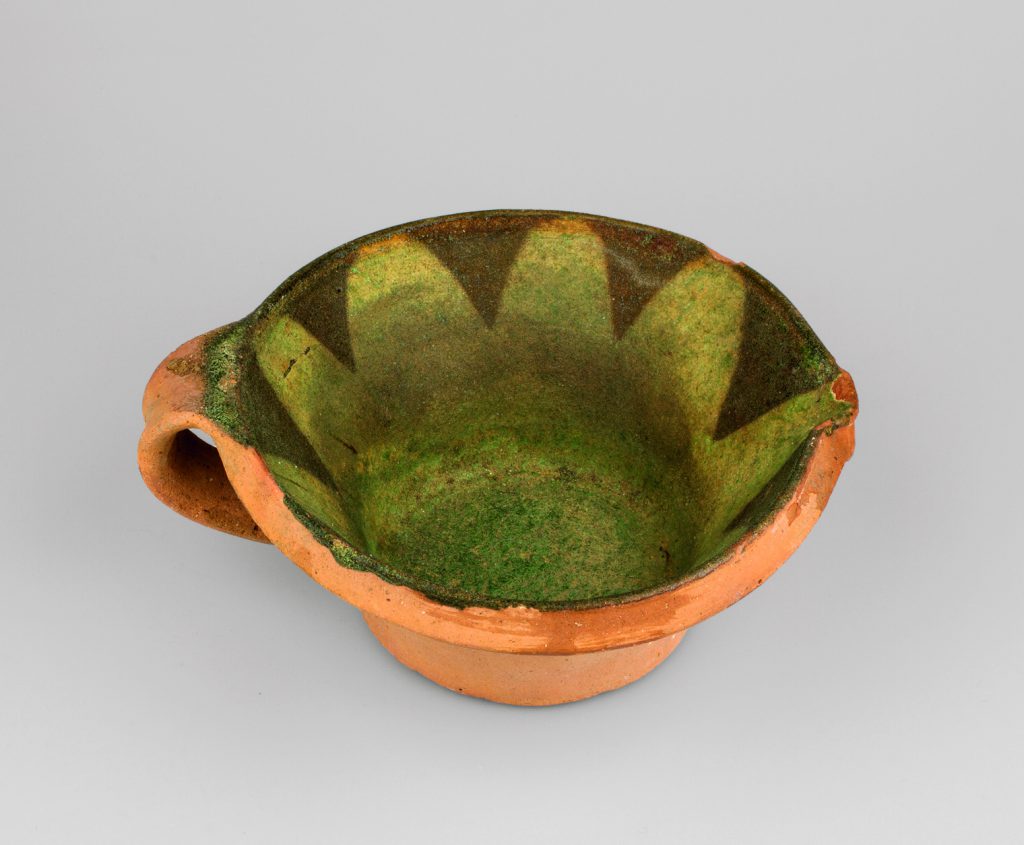
Bowl with a geometric decoration with white slip from the shipwreck.
Laténium
parc et musée d’archéologie de Neuchâtel
Espace Paul Vouga
CH-2068 Hauterive
Tel.: +41 (0)32 889 69 17
latenium@ne.ch
Roland Blaettler, Jonathan Frey, Lara Tremblay, 2022
An unusual case: the wreck from Hauterive
Since the early 20th century, the nets of fishermen on Lake Neuchâtel were regularly getting snagged on a mysterious sunken object approximately 1.2 km from the port of Hauterive. In one incident that occurred some time between 1910 and 1920, one of the nets had even contained a number of ceramic and bronze objects when it was hauled to the surface. Much later, in 1970, the finds actually resurfaced on the art market (Laténium HR-E16-60499; Laténium HR-E16-60498; Laténium HR-E16-60804; Laténium HR-E16-60504; Laténium HR-E16-60503). In 1961, a diver secretly made a search of the area and brought up an assemblage of green-glazed pottery and metal objects. The finds were confiscated in 1962 and handed over to the archaeological museum in Neuchâtel (Laténium HR-E16-60802; Laténium HR-E16-32; Laténium HR-E16-17; Laténium HR-E16-18; Laténium HR-E16-45; Laténium HR-E16-66; Laténium HR-E16-60501; Laténium HR-E16-60801; Laténium HR-E16-61; Laténium HR-E16-5; Laténium HR-E16-60810). An initial test dive by the authorities that same year led to the identification of a shipwreck, or rather the cargo of a barge which had sunk during the 16th century. It was not until 1980, that the cantonal Department of Archaeology was able to mount a systematic underwater excavation at the site. The divers did not find any remains of the barge itself but recovered a large quantity of ceramic vessel fragments and various metal objects including dozens of iron ingots weighing several hundred kilograms (Arnold 1982; Egloff 1980). Apart from the ingots, which were intended for the metal industry, the load also included a large range of glazed earthenware with several of the shapes being represented by multiple specimens.
The complete absence of wear on the crockery shows that the vessels had come directly from an unknown potter’s workshop, which must have been located either on the shore of Lake Neuchâtel itself or on one of the rivers that flow into it. The destination of the delivery, however, is unknown (for more information see Arnold/Frey/Tremblay 2024).
The assemblage consists of hundreds of fragments and a few dozen whole vessels, which either remained intact or could at least be restored. Overall, the ceramic finds represent just under 200 individual vessels. This type of everyday ware is usually found on archaeological excavations in waste pits or earth deposits. The wreck has now provided us with vessels that, despite a certain degree of weathering from being submerged in water for a long time, are practically new; objects which would have been destined for a customer or perhaps a salesman somewhere in the Three Lakes Region.
The assemblage consists of cooking vessels such as tripod skillets, lidded pots with handles and colanders with tubular handles. A large dripping dish was an unusual find. Multifunctional bowls such as those with projecting collared rims are often found. The actual tableware included bowls with thickened rims and horizontal lug handles and a small number of shallow dishes with pedestal feet, flanges and thickened rims. A flagon, a costrel and a wash basin completed the range of forms.
Based on a plank whose outermost ring was dated to 1547 and the fact that ships and boats were built from dry wood we can deduce that the barge was built in the 1560s. Assuming that a barge like that would generally have remained in use for approximately 30 years, the wreck would have occurred sometime between 1560 and 1590. This fits the ceramic shapes, since the bowls with projecting collared rims have quite a high lip and make up a large proportion of the range of forms. The complete absence of bowls with flared rims, together with a strong presence of bowls with thickened rims and opposing horizontal lug handles attached to the thickened areas show that from a cultural point of view the pottery would not have originated from the Bern and Fribourg region or its peripheral areas but rather from much further west. It is therefore not at all surprising that the assemblage contained only a few vessels with slip-trailing and none at all with incised decoration, both of which one would have expected to find in pottery from the German-speaking part of Switzerland in the last quarter of the 16th century. Instead, the finds included numerous vessels with geometric decoration with white slip and several others where a coat of slip was deliberately applied in smudges so that they gave the appearance of being marbled.
It is therefore likely that the cargo was lost in the last quarter of the 16th century.
The first version of this text was published in: Blaettler/Ducret/Schnyder 2013, 46 – Last review by Jonathan Frey and Lara Tremblay on 6/10/2022.
Translation Sandy Haemmerle
References:
Arnold 1982
Béat Arnold, Fouille d’une épave du XVIe siècle dans le lac de Neuchâtel, au large d’Hauterive, in: Musée neuchâtelois, 1982, 53-72.
Arnold 2004
Béat Arnold, A page of naval archaeology illustrated by the close examination of some traditional boat craft from Lake Neuchâtel, Switzerland, in: Klaus Brandt/Hans Joachim Kühn (Hrsg.), Der Prahm aus dem Hafen von Haithabu. Beiträge zu antiken und mittelalterlichen Flachbodenschiffen, Neumünster 2004, 97-103.
Arnold/Frey/Tremblay 2024
Béat Arnold/Jonathan Frey/Lara Tremblay (2024). „Une riche cargaison d’artefacts engloutis dans le lac de Neuchâtel au dernier tiers du 16e siècle“, Jahrbuch Archäologie Schweiz 107, 2024, 39-86.
Blaettler/Ducret/Schnyder 2013
Roland Blaettler/Peter Ducret/Rudolf Schnyder, CERAMICA CH I: Neuchâtel (Inventaire national de la céramique dans les collections publiques suisses, 1500-1950), Sulgen 2013.
Egloff 1980
Michel Egloff, Des nécropoles burgondes à l’épave d’Hauterive, in: Helvetia archeologica 43/44, 1980, 196-205.
Reitmaier 2008
Thomas Reitmaier, Vorindustrielle Lastsegelschiffe in der Schweiz (Schweizer Beiträge zur Kulturgeschichte und Archäologie des Mittelalters 35), Basel 2008, 23.

